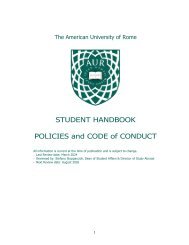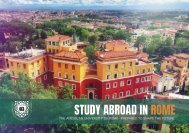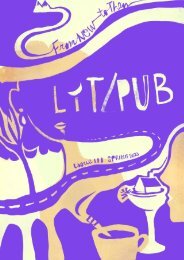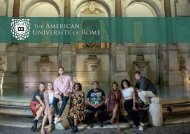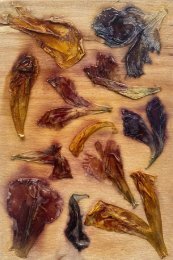You also want an ePaper? Increase the reach of your titles
YUMPU automatically turns print PDFs into web optimized ePapers that Google loves.
ITALY<br />
DEC. <strong>2020</strong> • ISSUE. 5<br />
I N G E N E R A L<br />
UNCOVERING<br />
THE UNUSUAL
LETTER TO THE EDITOR<br />
Dear Editor,<br />
As an Expat that has lived in Rome for about 3 years, I’ve really enjoyed reading the past four issues of <strong>Italy</strong> in<br />
<strong>General</strong>. A friend of me gave me the first issue of the magazine, and I was immediately hooked! The past issue<br />
really did help take my mind off of life in the quarantine, and truly was a ray of hope during some of the darker<br />
days of the lock-down. Your publication has inspired me to go out and explore Rome (and beyond) more than I<br />
have in the past years, so a BIG thank you to he creative team that searches out the best features of <strong>Italy</strong> to help<br />
us readers explore more.<br />
Now that we are starting to see a little hope of life returning to “normal,” I was wondering if there were some<br />
“unusual” things in <strong>Italy</strong> to start discovering once we get back to our previous routines. I’m sure that this year<br />
has been equally challenging for all of you, but I trust that you will once again deliver some great features that we<br />
absolutely must go out and experience.<br />
Hoping you’re staying safe through all of this.<br />
Kind regards,<br />
Mike<br />
Dear Mike,<br />
We have worked long and hard in-spite of these historic times to create a magazine that shows the unusualness<br />
of <strong>Italy</strong> despite the unusual barriers this semester has presented us with. We suffered the wrath of wearing<br />
itchy masks to class, working with intermittent internet connections, and a cramped academic schedule.<br />
However, as unusual as this semester has been, we’ve worked very hard to represent the grit of the FDM 105<br />
class of Fall <strong>2020</strong>.<br />
That grit is represented by every click of the mouse, font on the page, and color of the border with the hopes<br />
that said grit will be represented within the pages of this new issue. We searched high and low to uncover the<br />
best and most unusual things that <strong>Italy</strong> has to offer. I hope you have a big appetite, as we’ve served up 2 great<br />
sections of unusual food to try here in <strong>Italy</strong>. Your sense of adventure will be entertained by the travel options<br />
that we’ve covered, and you’ll also be happy to discover some unusual sports, art, and wellness tips. I hope<br />
that this issue holds your head high towards the future where all of the unusual things can be explored and<br />
enjoyed in the purest form.<br />
Stay unusual,<br />
Finn Perlestein<br />
Editor<br />
2 | <strong>Italy</strong> in <strong>General</strong> <strong>Issue</strong> 5 - <strong>Dec</strong>ember <strong>2020</strong> | 3
WHAT’S ON THE MENU THIS ISSUE<br />
UNUSUALLY WELL<br />
8<br />
UNUSUAL FOOD - PT1<br />
12<br />
UNUSUAL WORDS<br />
17<br />
THINGS NOT TO DO<br />
22<br />
UNUSUAL GEMS IN ROME<br />
28<br />
UNUSUAL FASHION<br />
33<br />
AUR PHOTOGRAPHY<br />
40<br />
UNUSUAL FOOD - PT2<br />
42<br />
UNUSUAL TRAVEL<br />
47<br />
UNUSUAL ITALIAN SPORTS<br />
53<br />
UNUSUAL ART<br />
58<br />
UNUSUAL LIVING SPACES<br />
62<br />
UNUSUAL ART<br />
67<br />
Photo by: Prof. Brian Koperski<br />
4 | <strong>Italy</strong> in <strong>General</strong> <strong>Issue</strong> 5 - <strong>Dec</strong>ember <strong>2020</strong> | 5
MEET THE CREATIVE TEAM<br />
DANIELA<br />
ARIDA<br />
KLARKE<br />
ARMSTRONG<br />
CHIARA<br />
De MATTIA<br />
KIRSTEN<br />
GALBRAITH<br />
ADAIR<br />
HOLTON<br />
ETHAN<br />
KNOWLES<br />
JASON<br />
MATTIA<br />
VICTORIA<br />
McATEER<br />
FINN<br />
PERELSTEIN<br />
ALESSANDRO<br />
RONGONI<br />
KAITLYN<br />
TARLTON<br />
ANGELICA<br />
ZAWADZKI<br />
6 | <strong>Italy</strong> in <strong>General</strong> <strong>Issue</strong> 5 - <strong>Dec</strong>ember <strong>2020</strong> | 7
Olive Trees with Yellow Sky and Sun (1889)<br />
Vincent Van Gogh<br />
8 | <strong>Italy</strong> in <strong>General</strong> <strong>Issue</strong> 5 - <strong>Dec</strong>ember <strong>2020</strong> | 9
SOFT HANDS<br />
& HEALTHY<br />
NAILS<br />
10 | <strong>Italy</strong> in <strong>General</strong> <strong>Issue</strong> 5 - <strong>Dec</strong>ember <strong>2020</strong> | 11
UNUSUAL ITALIAN<br />
FOODS YOU SHOULD<br />
-ked with salt, pepper, nutmeg, and occasionally parsley.<br />
Coppa di testa can be traced back to the early 19th century<br />
in the North-central regions of Emilia Romagna,<br />
Abruzzo, Umbria, Marche, and Tuscany. You can eat<br />
this delectable food sliced or diced, and it may be found<br />
in appetizers in these regions.<br />
PAJATA<br />
3<br />
KNOW ABOUT<br />
Written by: Kaitlyn Tarlton<br />
<strong>Italy</strong> has constantly been rated as the best cuisine in the world by many people across the globe. Everyone<br />
in the world recognizes <strong>Italy</strong> for the creation of mouth-watering pasta dishes and infamous pizza as we<br />
know it today. However, there is much more to Italian food than meets the eye. A great way to understand<br />
the Italian food scene is to eat what the locals eat. While many Italians indulge in Carbonara and Prosciutto,<br />
they also enjoy uncommon dishes that also have humble beginnings. <strong>In</strong> <strong>Italy</strong>, nothing gets wasted, and<br />
every part of animals and vegetables are used to create dishes packed with flavor that we know and love today. If<br />
you are an adventurous eater, these foods are made for you. From usual cheeses to unusual cuts of meat, Italian<br />
cuisine has an endless number of dishes you never thought about tasting. Here are just some of the Italian foods<br />
you should know about, and possibly try out.<br />
CASU MARZU<br />
Casu Marzu is a cheese, with a special surprise<br />
inside, that originates from Sardinia and is considered a<br />
delicacy on the island. It is crafted by infusing the sheep<br />
milk cheese with insect larvae, which is why the EU<br />
considers this cheese illegal. The larvae eat and digest<br />
the cheese making it creamy inside. When it comes<br />
time for humans to consume casu marzu, the larvae<br />
stay in the cheese and are eaten with it while they remain<br />
alive. Despite casu marzu being outlawed, Sardinian<br />
people still eat and produce this cheese. Cazu<br />
marzu is only produced in the spring and summer, and<br />
the price ranges from 20 euro per kilo to 100 euro per<br />
kilo. If you are interested in trying this cheese, travel to<br />
the beautiful island of Sardinia to have a taste because<br />
this cheese can be found nowhere else in the world.<br />
Coppa di Testa. Photo by: Lorenzo Vinci Magazine<br />
2<br />
1<br />
Casu Marzu. Photo by: Shardan via Wikimedia Comms<br />
COPPA DI<br />
TESTA<br />
Coppa di Testa is a cooked sausagemade from<br />
the remaining parts of the pig that are not commonly<br />
used. Pork is often used to prepare cuts such as ham,<br />
pancetta, and salami, but the leftover head, rinds, and<br />
tongue is used to make this food. These parts are coo-<br />
Pajata. Photo by:<br />
Il Club di Ricette<br />
Pajata is a classic Roman<br />
dish that many locals love to<br />
eat. If you love Italian food,<br />
you need to try this dish because<br />
it encompasses everything<br />
about Roman cuisine.<br />
Pajata is the intestines of<br />
veal and is commonly served<br />
as a pasta sauce with rigatoni<br />
noodles. The dish is rich in<br />
flavor and creamy because<br />
the milk that was previously<br />
consumed by the cow remain<br />
inside of the intestines<br />
when harvested. As the veal<br />
cooks, the milk transforms<br />
to a ricotta like texture.<br />
This dish was previously<br />
banned by the EU in the<br />
early 2010s due to the mad<br />
cow’s disease, but made a strong comeback in 2015. Today, you can find this dish in many trattorias<br />
and osterias around Rome. The best places to look are in the popular neighborhoods of<br />
Testaccio, Trastevere, and Garbatella.<br />
CERVELLI<br />
FRITTI<br />
Cervelli Fritii translates to fried<br />
brains in English. Don’t let the name scare<br />
you off yet. Cervelli fritti is prepared with<br />
the brains of young calves, lambs, or veal.<br />
They are coated in eggs and flour and fried<br />
to golden perfection. The texture is similar to<br />
cheese because it is creamy in the center. This dish<br />
is commonly found in the Tuscany and Lazio regions.<br />
Many osterias and trattorias serve this dish as an appetizer and<br />
are waiting for you to try. Drizzle a squeeze of lemon juice on top for an extra<br />
kick.<br />
Go to Ristorante da Nazzareno to try this dish. They serve this dish<br />
along with a side of fried artichokes. Many locals rave about this resturant for<br />
this dish and the excellent service.<br />
Cervelli Fritti.<br />
Photo by: Plutonia<br />
Publications<br />
12 | <strong>Italy</strong> in <strong>General</strong> <strong>Issue</strong> 5 - <strong>Dec</strong>ember <strong>2020</strong> | 13
5<br />
Door mouse. Photo by: Katie Berry<br />
STUFFED<br />
DOORMICE<br />
Although you may find this dish<br />
strange at first, stuffed dormice have very<br />
humble beginnings. Stuffed Mice is a<br />
dish unique to the southern region of<br />
Calabria and now considered a delicacy<br />
due to its ancient origins. Stuffed mice<br />
have been around since Julias Caesar was in<br />
charge of the Roman Empire. Traditionally,<br />
the mouse is stuffed with ground meat such as<br />
rabbit, pork, or beef, along with onions, various<br />
herbs, nuts, and spices. If you are looking to taste<br />
this dish, travel to Calabria because this dish is not<br />
common in the other regions of <strong>Italy</strong>.<br />
6<br />
TRIPPA ALLA ROMANA<br />
Trippa alla Romana is a dish that was by the<br />
poor in Rome hundreds of years ago and is still a beloved<br />
dish consumed today. Trippe alla Romana is<br />
made with tripe. One of the four stomachs of a<br />
cow. Many cultures make tripe, but <strong>Italy</strong> does<br />
it better (like most food). It is braised with<br />
white wine, onions, tomatoes, carrots, and<br />
salty pecorino romano. To be traditional,<br />
consume this dish on a Saturday for “Sabato<br />
Trippa.” You may find this dish in the<br />
fanciest to the most family style restaurants<br />
all around Rome.<br />
Some resturants that serve this dish<br />
around Rome include Piatto Romano, Agustarello<br />
a Testaccio, and Flavio al Velavevodetto.<br />
This restaurants are located in the Trastevere/Testaccio<br />
area are are highly credited for<br />
this dish.<br />
Tripe. Photo by: Guy Docetoni<br />
Trippa alla<br />
Romana. Photo<br />
by: Sabrina Tocchio<br />
LAMPREDOTTO<br />
7<br />
8<br />
Lampredotto is a Florentine sandwich<br />
made with more tripe! However, lampredotto is<br />
prepared by using the last stomach of the cow. It is<br />
a common food to find in the beautiful streets of<br />
Florence. The stomach is slow cooked in broth and<br />
herbs, then served inside of a large bread roll. Most<br />
of the time, it will also be served with a spicy green<br />
sauce.<br />
Lampredotto. Photo by: Antonino Crescenti<br />
Coda alla Vaccinara. Photo by: Toni Brancatisano<br />
CODA ALLA<br />
VACCINARA<br />
While many Romans love to eat Coda alla Vaccinara,<br />
many people from different countries may consider<br />
this dish unusual. Coda alla Vaccinara is more well<br />
known as Oxtail Stew in English. This dish is quintessential<br />
Roman cuisine and was at one point consumed<br />
so much that citizens in Rome were called ‘mangiacode’<br />
(tail eaters). The oxtails are prepared with a hefty<br />
amount of celery, and other vegetables, herbs, and wine.<br />
You may stumble across this dish in most trattorias in<br />
Testaccio and Trastevere.<br />
C<br />
M<br />
Y<br />
CM<br />
MY<br />
CY<br />
CMY<br />
K<br />
<strong>Italy</strong>’s no. 1 Pasta<br />
WHO KNEW<br />
A BOWL<br />
OF PASTA<br />
COULD<br />
GIVE YOU<br />
BUTTERFLIES<br />
14 | <strong>Italy</strong> in <strong>General</strong> <strong>Issue</strong> 5 - <strong>Dec</strong>ember <strong>2020</strong> | 15
UNUSUAL WORDS<br />
FOR<br />
UNUSUAL MEANINGS<br />
Chiara De Mattia<br />
You probably never heard this sentence: “Senti st’olive a Se”, “so<br />
bone, so greche”. Whether you have heard strange sentences in Italian<br />
or not, many of them have different meanings than their litteral<br />
ones. <strong>In</strong> the next pages, I am going to explain some unusual words<br />
I have heard all my life, and if you stay in <strong>Italy</strong> for a while, you will<br />
probably hear them too. Some funny, some not, these words are also<br />
the basics of some Italian dialects. Did you know that <strong>Italy</strong> has over<br />
thirty different dialects? Old people from the south would most likely<br />
not understand a word of an old man from the far north. This article<br />
will take you through a quick journey and give you a taste of what<br />
it means to be a true Italian. <strong>In</strong> other words, non capirci un tubo!<br />
16 | <strong>Italy</strong> in <strong>General</strong> <strong>Issue</strong> 5 - <strong>Dec</strong>ember <strong>2020</strong> | 17
6 UNUSUAL COMMON SAYINGS<br />
Stare con le mani in mano<br />
The literal translation is: “to be with<br />
your hands in your hands”<br />
The English equivalent is: “to sit on<br />
your hands”.<br />
This saying is used when someone<br />
doesn’t do anything when he is supposed<br />
to, and also when has poor manners<br />
when invited to a dinner or party<br />
and doesn’t bring anything as a little<br />
gift.<br />
4 UNSUSUAL WORDS OF ITALIAN DIALECTS<br />
Belin<br />
Filler used by the Genoese in many<br />
situations, in general it means “penis”<br />
but can be used in many contexts<br />
in both negative and positive<br />
ways.<br />
For example, if something unexpected<br />
happens you say “belin what<br />
happened?”<br />
Daje<br />
From the deepest sounds of Rome,<br />
“daje” is a normal exclamation<br />
word, that usually means “ok”,<br />
“yes”, “sounds good”. Its meaning<br />
is similar to “figa”, but is stronger<br />
and more passionate. For example,<br />
when they ask you “ do you want a<br />
supplì? You answer “daje”.<br />
Figa<br />
Typical Milanese filler used to make<br />
appreciation. <strong>In</strong> general, it means<br />
“beautiful” or “fantastic”.<br />
For example, if you are invited to a<br />
party and they ask “are you coming<br />
to the party?” You answer “Figa if I<br />
come!”<br />
Jamme Jà<br />
“Jamm’ Jà” literally translated, as<br />
we all know, means “let’s move on”,<br />
“hurry up”, “let’s hurry up”.<br />
For example, if someone says “let’s<br />
go get some pizza” You answer<br />
“Jamme Jà!”<br />
Non ci piove<br />
The literal translation is: “it doesn’t rain<br />
on it”.<br />
The English equivalent is: “no doubts<br />
about it”<br />
You can use this expression when you<br />
are extremely confident about what you<br />
are saying and you have no doubts about<br />
that. Also, it can be a way to cut short a<br />
conversation when you don’t think it is<br />
useful to take it further: your conclusion<br />
is the only one that makes sense!<br />
Acqua in bocca!<br />
The literal translation is: “water in your<br />
mouth”.<br />
The English equivalent is: “Keep it for<br />
yourself !”<br />
This expression is used when you tell a<br />
secret to someone. For instance, if you<br />
tell a gossip like “she kissed him” to<br />
your friend then you say “acqua in bocca!”<br />
Avere un diavolo per<br />
capello<br />
The literal translation is: “to have a demon<br />
for each hair”<br />
The English equivalent is: “to be as<br />
mad as hell“.<br />
Imagine someone furious with as many<br />
demons as his hair sitting on his shoulder:<br />
well, now you can understand how<br />
effective this idiom is!<br />
18 | <strong>Italy</strong> in <strong>General</strong> <strong>Issue</strong> 5 - <strong>Dec</strong>ember <strong>2020</strong> | 19
Chiodo scaccia chiodo<br />
The literal translation is: “chiodo”<br />
means “nail” and “scacciare” means<br />
“to drive away”.<br />
The English equivalent is: “a nail drives<br />
another nail away”.<br />
It refers to the fact that one thing replaces<br />
another. <strong>In</strong> English we would use<br />
“a problem drives another one away”,<br />
however in the original version the idiom<br />
does not refer only to problems but<br />
to things in general.<br />
Non avere peli sulla lingua<br />
The literal translation is: “not to have<br />
hairs on your tongue”.<br />
The English equivalent is: “not to mince<br />
one’s words”<br />
This means to be straightforward and get<br />
to the point. It is often said when someone<br />
is trying to get their point across but<br />
are being very careful about what to say<br />
because they do not want to cause any<br />
offense. You would then tell this person<br />
not to mince their words, or now you can<br />
say “non avere peli sulla lingua!”<br />
20 | <strong>Italy</strong> in <strong>General</strong> <strong>Issue</strong> 5 - <strong>Dec</strong>ember <strong>2020</strong> | 21
Things Not to Do <strong>In</strong><br />
<strong>Italy</strong><br />
Written by Daniela Arida<br />
When one thinks of <strong>Italy</strong>, they will mostly imagine the famous sites and other stereotypes of <strong>Italy</strong> and Italians<br />
but what they are less likely to know are the things to avoid doing in <strong>Italy</strong> and its probably things you do not<br />
expect. So here is some advice for you to know before your trip to our Fabulous <strong>Italy</strong>.<br />
Concerning Food and eating : Food is a very sacred thing for Italians and as we all know <strong>Italy</strong> produces some<br />
of the best cuisine in the world therefore they are easily offended if you do something that they do not approve<br />
of. Here are some don’ts<br />
4.<br />
Do not expect a big breakfast, Italian’s only<br />
have a Cornetto or if you are up north a Brioche. That<br />
is all they eat for breakfast with either their cappuccino<br />
or espresso<br />
5.<br />
Coffee is sacred and for Italians an important<br />
part of the daily routine. Never order a cappuccino<br />
after midday and if you order your usual latte you<br />
will probably be disappointed to be given a glass of<br />
milk.<br />
1.<br />
Do not cut your pasta. If you order a plate of spaghetti, do not use your knife, just twirl it<br />
around your fork and eat it, if you struggle with that, just use the spoon to help keep the spaghetti on<br />
the fork.<br />
2.<br />
Do not put Parmesan cheese on seafood. A lot of people put cheese on all their pastas<br />
and come to <strong>Italy</strong> thinking that Italians put Parmesan cheese on all pasta dishes, they don’t.<br />
3.<br />
Pineapple on pizza is a NOOO! You might find it in some tourist restaurants, but<br />
for Italians no way, fruit does not go on pizza. Neither does Ketchup ! Pizza has its own<br />
tomato sauce.<br />
6.<br />
Pizza also has its own<br />
guidelines. Italians will never eat<br />
an individual round pizza for<br />
lunch, preferring instead to grab<br />
a pizza taglio to either eat at the bar or take home.<br />
7.<br />
Eating on the go.<br />
You’ll rarely see image-conscious<br />
Italians eating snacks<br />
while walking. Taking the<br />
time to sit down and eat or<br />
drink “properly” is of huge<br />
importance. Florentines have an intense dislike of<br />
seeing tourists eat slices of pizza as they walk and<br />
think people should sit and give food the attention it<br />
deserves. <strong>In</strong> Florence, snacking on certain historical<br />
streets is actually banned and you can find yourself<br />
with a €500 fine. Likewise a takeout coffee (heaven<br />
forbid) is frowned upon and worse brewing your<br />
own coffee in the streets with a camping stove…<br />
Two backpackers were fined €900 recently in Venice<br />
for brewing a morning coffee at the foot of the<br />
Rialto bridge.<br />
22 | <strong>Italy</strong> in <strong>General</strong> <strong>Issue</strong> 5 - <strong>Dec</strong>ember <strong>2020</strong> | 23
<strong>General</strong> Do Nots and Precautions :<br />
1.<br />
Do not expect things to go according<br />
to schedule. Italians have a hard time keeping<br />
to schedules. If you have a bus schedule and wait<br />
for the bus at the appointed time, don’t expect it to<br />
come on time, it will rarely happen, especially in<br />
Rome, they are the worst. Another thing is Italians<br />
love to take their time, so don’t expect your tight<br />
scheduled plan to work as anything can happen.<br />
3.<br />
Steal sand. Sardinia has cracked down on “sand<br />
theft” in an effort to protect its fragile environment. It<br />
might have never crossed your mind, but there are people<br />
who take sand home from beaches as souvenirs (which<br />
could seem normal) while plenty of us accidentally take<br />
it home on our clothes or beach towels. Anyone found<br />
smuggling sand in their suitcases can now be fined up to<br />
€3,000. There was one couple who tried to take a whopping<br />
40kg of sand home with them now face jail time.<br />
5.<br />
Flip-Flop Protocol and Swimwear. For Italians<br />
flip-flops are worn to go to the beach or around<br />
the house. Not however to go hiking ! Local authorities<br />
in the popular seaside destination of Cinque Terre have<br />
begged visitors to stop wearing flip-flops on its hiking<br />
trails and are tired of the 118 being called to rescue<br />
stranded tourists, authorities are now handing out fines<br />
ranging from €50 to €2,500 to anyone caught endangering<br />
themselves with a poor choice of footwear. Wear a<br />
swimsuit, yes but at the beach ! Italians are very conscious<br />
about what they wear out and usually dress to impress.<br />
Regular complaints about visitors in major cities<br />
dressing as if they’re at the beach has brought in some<br />
new rules, Venice and Rome has completely banned<br />
swimwear and sunbathing in the center and walking<br />
around shirtless (or topless)<br />
will get you into trouble as well.<br />
6.<br />
Day-tripping, without paying, is now<br />
against the law. Be careful if you come to Venice<br />
on a day trip: Anyone who visits<br />
the city must pay a daily tax of $10<br />
or risk penalties up to €450 ($502).<br />
2.<br />
Do not rely only on using credit cards. <strong>In</strong> most<br />
parts of the world now people are able to use credits<br />
cards to pay even the slightest amounts. <strong>In</strong> some places<br />
such as cafes or ice cream parlors you can only use<br />
your credit cards if the bill is a minimum of 5 euros.<br />
4.<br />
Swim in a canal. You might have thought<br />
that it would be a lifetime experience to swim in the canals<br />
of Venice. Several people have found themselves in<br />
trouble with police in the past few years after going for<br />
a swim in Venice’s canals on a hot summer’s day. Even<br />
dipping a toe or putting your feet in is banned, too.<br />
7.<br />
Sitting on the<br />
steps. Sitting on Rome’s famous<br />
Spanish Steps, or on<br />
the steps of the Tomb of<br />
the Unknown Soldier was,<br />
until very recently, a very typical thing to do on<br />
a summer evening in the city but a new law makes<br />
this a thing of the past. It’s now prohibited to sit<br />
on historic steps, which were built in the 1700s<br />
and recently restored at a cost of 1.5 million euros.<br />
8.<br />
Use a drinking fountain<br />
incorrectly. This one might<br />
come as a shocker. Rome has<br />
another type of fountain, those<br />
that spout fresh drinking water. But using them improperly,<br />
putting your mouth to the tap which is not<br />
how they do it, or even washing your feet in them can<br />
incur the wrath of locals and also land you with a fine.<br />
24 | <strong>Italy</strong> in <strong>General</strong> <strong>Issue</strong> 5 - <strong>Dec</strong>ember <strong>2020</strong> | 25
THE AMERICAN UNIVIERSITY OF ROME PRESENTS<br />
HE WOLF<br />
Wolfie’s Autobiography<br />
26 | <strong>Italy</strong> in <strong>General</strong> <strong>Issue</strong> 5 - <strong>Dec</strong>ember <strong>2020</strong> | 27<br />
Written by D. L Prinze
Unusual Gems in Rome<br />
Finn Perelstein<br />
Villa Pamphili<br />
Villa Pamphili, one of the most unknown and<br />
underrated gems of Rome. Although there is<br />
a Villa located in the center, when Italians say<br />
“Villa Pamphili” they think of a big park. One<br />
that hosts locals to their favorite recreational activities.<br />
People go to the park to run, walk, ride<br />
bikes, play sports, and any other activity that<br />
serves 1.8km 2 of space. Within the park touristic<br />
delacasies such as the Vivi Bistrot, a resutraunt<br />
in the middle of<br />
the park with a view of<br />
Villa Pamphilli’s swooping<br />
hills exist. However,<br />
more adventurous<br />
and unusal gems can be<br />
found.<br />
The Underwater Cave<br />
On the northern side of Belvedere lake, there<br />
is a stream that paralells a path which, takes<br />
you up to a fountain. Right before the fountain,<br />
there are stone stairs that lead down to<br />
a cave. When looking at the staircase it as if<br />
the stairs would lead underground, under the<br />
stream, and in fact that is exactly what they do.<br />
There is a cave like tunnel that traverses under<br />
the stream where the water from the stream<br />
flows directly above and flows down, looking<br />
like an underwater cave.<br />
28 | <strong>Italy</strong> in <strong>General</strong> <strong>Issue</strong> 5 - <strong>Dec</strong>ember <strong>2020</strong> | 29
Quartiere Coppedè<br />
Quartiere Coppede, although looks home<br />
to Dr. Suess, is a neighborhood filled with<br />
the top political minds of Rome from all<br />
over the world. The Architecture of the<br />
highlighted building in the neighborhood<br />
seems as though Gino Coppede’, the architect,<br />
was tripping on acid while drawing<br />
up the blue prints which gives the main<br />
building and the arch an almost fairytail<br />
look. One you would see in a Disney movie.<br />
However, most of the inspiration Coppede<br />
drew from came from nature which<br />
you can see in the designs in stone one almost<br />
every corner of the main buildings.<br />
All around the center building and fountain<br />
hosts embassies including the Canadian,<br />
Moroccan, New Zealand and many<br />
more embassies.<br />
The Aventine Key Hole<br />
Th e Aventine keyhole is one of the most unusual yet majestic,<br />
and ill be it, satisfying places in Rome. Aventine hill<br />
is one of the 7 hills that Rome was built on which gives<br />
whoever is look-<br />
ing through the keyhole<br />
a straight shot<br />
view of the Cupola of<br />
St. Peters. Al-<br />
though you cannot<br />
enter into the<br />
Villa del Priorato<br />
di Malta, the<br />
gate to the garden<br />
has a<br />
tiny hole which<br />
shows<br />
the epically<br />
framed, by<br />
the hedges in<br />
the fore-<br />
ground, Cupola<br />
in the<br />
background.<br />
30 | <strong>Italy</strong> in <strong>General</strong> <strong>Issue</strong> 5 - <strong>Dec</strong>ember <strong>2020</strong> | 31
UNUSUAL<br />
FASHION<br />
ITALY<br />
BY KIRSTEN GALBRAITH<br />
32 | <strong>Italy</strong> in <strong>General</strong> <strong>Issue</strong> 5 - <strong>Dec</strong>ember <strong>2020</strong> | 33
THE ONLY BOOK YOU<br />
WILL EVER NEED TO UN-<br />
DERSTAND THE WORLD OF<br />
FASHION!<br />
Writer and journalist Kirsten Galbraith decided to<br />
write and publish “Understanding Fashion” to open<br />
the eyes and minds of people who wish to know<br />
more about the world of fashion. The reader shall<br />
prepare to find not only the history and modern<br />
facts regarding fashion, but also interviews of international<br />
stylists who have decided to contribute their<br />
stories into the composition of this book. To name<br />
a few, Stefano Gabbana and Domenico Dolce have<br />
gladly shared their story about how they entered the<br />
fashion world up to how and when they became so<br />
undeniably famous and inspirational.<br />
The book also contains different quotes from different<br />
fashion designers and/or managers of the<br />
companies, to best make believe that fashion truly<br />
does have a long history to be explained. The goal of<br />
this book is to not only inform whoever is interested<br />
into learning more about this complicated and luxury<br />
wrold, but also to tell stories which have not been<br />
told, or told correctly. The main aim of the insertion<br />
of interviews and quotes is to make sure everyone<br />
who decided to be involved in the book is able to let<br />
their true story out to be known by a vast public of<br />
hungry readers and fashion fans.<br />
34 | <strong>Italy</strong> in <strong>General</strong> <strong>Issue</strong> 5 - <strong>Dec</strong>ember <strong>2020</strong> | 35
UNUSUAL<br />
FaSHION IN ITALY<br />
Gucci is one of the worlds<br />
most successful luxury<br />
brands, but is also totally<br />
“bananas”<br />
Dolce & Gabbana:<br />
High Class Unusual Tailoring<br />
<strong>In</strong> the 2018 Fall season, the two designer stylists<br />
Domenico Dolce and Stefano Gabbana have<br />
decied to move their own tailoring collection from<br />
the intimacy of the courtyard of their boutique<br />
in Corso Venezia to their main exposition area in<br />
Viale Piave. This collection shined of a thousand<br />
lights, for how full of gold, silver, zinc and other<br />
metallic materials. Elegant ceremony coats in<br />
tungsten jacquard color; smokings in rough cotton<br />
canvas in the color of alluminum; cachemire outfits<br />
in brunished nichel, and this only in the first ten<br />
outfits. A long show, rich in golden overcoats, frock<br />
coats with a cheetah metallic and brunished print<br />
or dust coats in a light sand color, golden as a liturgical<br />
parameter. Fashion brands have long known<br />
that haute couture and jewellery is complicated.<br />
But up until recently, modern luxury brands have<br />
not known how to diffuse the knowledge of fine<br />
craftsmanship and materials to the public. Today’s<br />
luxury consumer has a fresh take on modern taste<br />
levels, as the consumer still yearns for the knowledge<br />
and attributes with respect to the product. But it still<br />
takes a specialized craftsmanship like that of the Italian<br />
luxury brand Dolce & Gabbana to follow through<br />
flwlessly and unusually, for the most. This amazing<br />
and sometimes unusual luxury brand continues<br />
to surprise the public, opening up hearts and carrying<br />
them into a world where fashion is appreciated,<br />
loved and known to be unusual. People wordlwide<br />
are searching for knowledge when it comes to luxury<br />
items. The term “Haute couture” is French for “high<br />
sewing” or, more in general, “high fashion” custom<br />
fitted apparel made with exclusive and exquisite<br />
craftsmanship. The “unusualness” of most of the<br />
Dolce & Gabbana collections throughout the years<br />
are due to the stylist’s undeniable imagination and<br />
point of view in a world of high fashion, a job and a<br />
mind that not everyone is gifted to have. Their vision<br />
have always and continue to shock potential buyers<br />
globally, and they never fail to give us a “show”.<br />
Ever since Alessandro Michele became Gucci’s creative<br />
director in 2015, this luxury brand has become<br />
the hottest thing in fashion. Thanks to his intervention,<br />
the brand grew over 40% in 2016, overtaking<br />
other luxury brands such as Hermes. But how did he<br />
and Gucci follow this breathtaking performance on<br />
their first runway show of 2018? An the answer to<br />
this question is: by making their models walk on the<br />
runway “holding their own heads”. The collection<br />
included tweedy, embroidered and print-heavy nerd<br />
chic. Fun fact: the New York Yankees logo appeard<br />
on different pieces of the collection, because of the<br />
brand’s partnership with Dappen Dan. What Michele<br />
wanted to represent in this unusual catwalk isn’t as<br />
easy to interpret. As he seems to be a big fan of Reinassance<br />
art, these two-headed models probably were<br />
meant to be referred to depictions of Christian saints<br />
who were condemned to carry their own heads. Gucci<br />
quoted a line of Donna Haraway’s essay “Cyborg<br />
Manifesto”, on the “dualism and dichotomy of identidy”,<br />
suggesting the dual heads referred to the split<br />
in the self. Other than the models holding their own<br />
heads, this catwalk also represented other unusual accessories,<br />
such as a baby dragon, according to Gucci<br />
inspired by “the real story of an author who staged<br />
finding a baby dragon in his garage in Oxfordshire,<br />
England”. Another among these models, entered the<br />
catwalk with a third eye in the middle of her forehead,<br />
while different types of masks covered the faces<br />
of other models. As weird and unusual Gucci seems<br />
to be, this fashion show has been an undeniable hit.<br />
The brand is especially popular with with millennials,<br />
who seem to have walked down runways for the<br />
most part of their lives and are looking for brands<br />
with a unique point of view. And what can be more<br />
unique than the vision of Michele in his experience<br />
running Gucci?<br />
36 | <strong>Italy</strong> in <strong>General</strong> <strong>Issue</strong> 5 - <strong>Dec</strong>ember <strong>2020</strong> | 37
the zara<br />
fashion show<br />
Fashion Show 2017 campaign which reveals a colorful and unusual print rich collection ready for the<br />
coming season. Zara Woman 2017 collection features a top model cast such as Lea, Kiko Arai, Adut<br />
Akech, Vittoria Ceretti and Fran Summers. This lastest campaign celebrates fashion’s newfound sense<br />
of unusuality and diversity.<br />
38 | <strong>Italy</strong> in <strong>General</strong> <strong>Issue</strong> 5 - <strong>Dec</strong>ember <strong>2020</strong> | 39
PHOTOGRAPHY IN ROME: STUDIO & STILL LIFE<br />
FAFD 106 - SELECTED WORKS - FALL<br />
CHAPTERS by Mariam Almasri<br />
Exposure: 1/200 sec at f/5.6; ISO 100<br />
NEW YEARS by Nicole Bleichner<br />
Exposure: 1/250 sec at f/13; ISO 100<br />
TURN DAY INTO NIGHT by Meagan Gephart<br />
Exposure: 1/250 sec at f/22; ISO 100<br />
PORTRAIT OF NICOLE by Adriana Parrotta<br />
Exposure: 1/250 sec at f/16; ISO 100<br />
FEET UP by Camilla Romanelli<br />
Exposure: 1/250 sec at f/22; ISO 100<br />
TREASURE by Meagan Gephart<br />
Exposure: 1/50sec at f/5.6; ISO 400<br />
PORTRAIT OF ADRIANA by Lillian Pennypacker<br />
Exposure: 1/250 sec at f/16; ISO 100<br />
HUNGRY? by Lucio Bianchi<br />
Exposure: 1/250 sec at f/8; ISO 100<br />
SMOKE by Andrew Sagerson<br />
Exposure: 1/250 sec at f/16; ISO 100<br />
PUZZLED by Mariam Almasri<br />
Exposure: 1 sec at f/22; ISO 100<br />
40 | <strong>Italy</strong> in <strong>General</strong> <strong>Issue</strong> 5 - <strong>Dec</strong>ember <strong>2020</strong> | 41
Unusual Food<br />
by Klarke Armstrong<br />
5 Unusual American and Italian Dishes<br />
You May or May Not Want To Try When<br />
Bored.<br />
Rigatoni Con La Pajata<br />
A Traditional dish eaten in Rome, <strong>Italy</strong>. It is a made of<br />
calf intestant usually served in tomoto sauce. The special thing<br />
about this dish is that the calf is unwained from its mothers<br />
milk and although the intestines are cleaned, skinned and boiled<br />
the chyme from the baby cows last meal is left inside of the<br />
intestines. Although this dish is not very common anymore<br />
you can still find it in some traditional trattorias in Rome.<br />
42 | <strong>Italy</strong> in <strong>General</strong> <strong>Issue</strong> 5 - <strong>Dec</strong>ember <strong>2020</strong> | 43
Koolaid Pickles<br />
Koolaid Pickles(Also refered to as Koolickles) are<br />
Punctured whole pickles or sliced kosher or spicy<br />
pickles that sit in a secure jar for 4 days. They maintain<br />
a tangy koolaid taste while also being colorful and<br />
crunchy. These are often sold in Southern United States<br />
Deep Fried Butter<br />
Americans are known for<br />
frying everything so, when<br />
it came to butter I am sure<br />
it was a no brainer. This<br />
fatty treat is a hit in the<br />
South and can be found at any festival where they fry stuff(all of<br />
them). To make fried butter you would need to put a frozen block<br />
of butter on a stick and coat it in bater. Fry then drizzle some<br />
icing sugar, or sifted sugar over the delecay. If you happen to be at<br />
one of these festivals. make sure to try the fried, oreos, bacon,<br />
chocolate covered bacon, icecream, and twinkie and more.<br />
Pure Pig Fat- Lardo Di Colonnata<br />
If a melty lump of fried fat does not sound tasty. This is the dish for<br />
you. Lardo Di Colonnata is a slice of pork fat cured with spices. It<br />
is often served in the Tuscan town of Colonnata where it is a most<br />
prized dish. But, if you are on any diet other than Keto than watch<br />
out. This sesasoned lump of pig fat which looks and sounds like it<br />
has an amazong texture is a wopping 740 calories for just 4 slices.<br />
Maggot infested Cheese- Casu Marzu<br />
This delicacy was born and raised in Sardinia, <strong>Italy</strong>. This large<br />
Italian Island prepares this dish by cutting the rind off of a wheel<br />
of Pecorino and proceding to leave it outside for a couple of<br />
months. Once, flies are regularly laying eggs and hatching them<br />
then the cheese is ready. This dish is not for the people afraid of<br />
bugs. Once the dish is surved up on a plate with the larvas and<br />
flies. This is where the real fun begins. The larva and insects are<br />
known to jump up to 15cm. As you eat your Pane caraway and<br />
Casu Marzu.<br />
44 | <strong>Italy</strong> in <strong>General</strong> <strong>Issue</strong> 5 - <strong>Dec</strong>ember <strong>2020</strong> | 45
Unusual<br />
TRAVEL<br />
DESTINATIONS<br />
By Jason Mattia<br />
looking at the most unusual<br />
travel destinations<br />
in <strong>Italy</strong>!<br />
46 | <strong>Italy</strong> in <strong>General</strong> <strong>Issue</strong> 5 - <strong>Dec</strong>ember <strong>2020</strong> | 47
As crazy and wild as <strong>2020</strong> has been for<br />
us, it’s safe to say were all craving a trip<br />
in one way or another. To keep the unusual<br />
theme of <strong>2020</strong>, this list is one that can<br />
hopefully bring us comfort now and add<br />
to our list of desirable destinations later.<br />
All of these places are super close to the<br />
typical Italian cities we all know yet offer<br />
a unique experience that differs from the<br />
typical tourists travel itinerary.<br />
Rocca Calascio, Abruzzo<br />
Get your hiking boots and head to Rocca<br />
Calascio, where the views are endless in<br />
the beautiful region of Abruzzo. initially<br />
built as a watchtower in the 10th century<br />
or earlier, the fortress developed in size<br />
and complexity over a period of time, and<br />
now is left in a ruined, yet beautiful state.<br />
Pentedattilo, Calabria<br />
Below Monte Calvario, this ancient, Greek<br />
built town takes an adventure to get there,<br />
without any real means of public transportation<br />
to get there. Now abandoned,<br />
taking strolls through the empty streets<br />
will put you in another world. The town<br />
got its name from original greco-calabro,<br />
or Greek-Calabrian dialect Pentedattilo:<br />
penta + daktylos = five fingers.<br />
Castle of Monguelfo, South Tyrol<br />
Nestled in the North, near the Austrian<br />
border, is a piece of history definitely<br />
worth seeing. This old castle dates back<br />
1126 AD, and today is open to public to<br />
roam around and take tours to learn of all<br />
the history it has to offer.<br />
Most Unusual Travel Destinations<br />
in <strong>Italy</strong>!<br />
abruzzo<br />
lake resia<br />
Arcomagno beach, San Nicola Arcella<br />
For what is a usually quiet place, this<br />
beach setting is perfect for hitting the<br />
coast in fashion. The rock formations leave<br />
a unique spot for photos or gazing, while<br />
the beach is a great place to layout, and<br />
in the world of covid, a cozy space quiet<br />
enough to social distance.<br />
Santuario di San Romedio, Trentino<br />
<strong>In</strong> the reigion of Trentino, this sanctuary<br />
dates back to the 11th century, and according<br />
to legend, Saint Romedio lived here<br />
with his bear. Here you will find Five little<br />
churches stacked on top of each other,<br />
all built on a rocky hillside, connected by<br />
a long staircase with 131 steps! Grab your<br />
walking shoes and explore!<br />
Capestrano, Abruzzo<br />
<strong>In</strong> the quiet countryside of Abruzzo lies<br />
Capestano, a small town with a lot of<br />
charm. Spend your day wandering the<br />
town, visiting different shops, and checking<br />
out the Abbey of St. Peter and Mediceo<br />
Castle. With less than 1000 people living<br />
in the town, you’ll have open opportunity<br />
to explore the hillsides hassle free!<br />
Lake Resia<br />
This one is truly something else! Located<br />
in the north near the Swiss border is lake<br />
resia, or Reschensee in Italian. Home to<br />
the filming location of Netflix’s spooky<br />
Italian series, Curon, the Lake itself is very<br />
unique. Rising from the middle of the lake<br />
is an old clock tower, the only visible remains<br />
of the town of Graun, that is underwater!<br />
Arcomagno arcomagno beach<br />
48 | <strong>Italy</strong> in <strong>General</strong> <strong>Issue</strong> 5 - <strong>Dec</strong>ember <strong>2020</strong> | 49
Pentedattilo<br />
santuario di san eomedio<br />
castle of monguelfo<br />
...<br />
50 | <strong>Italy</strong> in <strong>General</strong><br />
italiair.it
UNUSUAL<br />
ITALIAN<br />
SPORTS<br />
By Alessandro Rongoni<br />
TAMBURELLO:<br />
The tambourine is a game created in Piedmont. This sport is the basis of the current tennis, you can find traces<br />
of this sport even in Roman times. The practice of this sport is therefore very ancient but even today you have<br />
days of it. As we said before, this sport has been used in tennis, but many still practice the tambourine. <strong>In</strong> fact,<br />
it was practiced a lot in <strong>Italy</strong> even until the 80’s. The name of this sport comes from the object with here you<br />
hit the ball, a small drum (tambourine). The rules are: The field of play is usually made of red clay, rectangular<br />
in shape, is 80 m long and 20 m wide, The field is bounded by white lines, and is divided by half by a line<br />
called cord, which divides the two halves of the field. At 40 m from this, in both directions, there is a bottom<br />
line. At 5 m from it, towards the center of the field is located the baseline. Normally the teams are composed<br />
of 5 players on the court at the same time and 4 on the bench for a total of 9 athletes available; the roles, from<br />
the most backward to the most advanced are: batter, thrower or shoulder, the score is counted as in tennis.<br />
52 | <strong>Italy</strong> in <strong>General</strong> <strong>Issue</strong> 5 - <strong>Dec</strong>ember <strong>2020</strong> | 53
SLITTINO :<br />
As a sport widely practiced in <strong>Italy</strong> we also<br />
have tobogganing. this sport is also an<br />
Olympic discipline that is practiced in the<br />
winter games. It consists in the fact that the<br />
competitor throws himself in a descent, of a<br />
traced route, to reach the finish line in the<br />
shortest possible time. This sport is very<br />
similar to bobsledding, which is always practiced<br />
as an Olympic discipline. Tobogganing<br />
is a very complicated sport, in fact you must<br />
have a perfect knowledge and discipline in<br />
the correct use of body weight to be able to<br />
have the greatest aerodynamics. This sport<br />
is very adrenaline, and also dangerous because<br />
you can reach speeds of 130 or 140<br />
km/h and therefore a fall would be fatal.<br />
This sport is practiced at very amateur<br />
levels, in fact it is enough to go to the<br />
mountains for the vacations and instead<br />
of renting skis you can rent a toboggan.<br />
IL LACROSSE:<br />
Lacrosse is a discipline that has taken shape in the last decade in <strong>Italy</strong>. This<br />
sport originates from North America, where it is practiced a lot. this sport is<br />
played with teams of 10 players who face each other (12 if the game is female),<br />
the goal is to put the ball, using a kind of triangular racket with canvas at the<br />
end, in the opponent’s goal, similar to ice hockey. The team that scores the most<br />
goals in the 80 minutes of regular play wins. The 80 minutes of play are divided<br />
into 4 quarters of 20 minutes each. This sport is played a lot in American colleges,<br />
but it has a minor success in Europe, but especially here in <strong>Italy</strong> because<br />
there is not a real professional championship only some associations practicing it<br />
54 | <strong>Italy</strong> in <strong>General</strong> <strong>Issue</strong> 5 - <strong>Dec</strong>ember <strong>2020</strong> | 55
CALCIO FIORENTINO :<br />
The calcio fiorentino is a sport practiced only in the Tuscan region. This sport is considered as the basis of<br />
soccer and rugby. It’s an event that takes place every year in June, this competition includes a challenge to the<br />
death between four teams: the blue, the green, the red and the white. The origins of this sport are Greek and<br />
then, the Romans took it back and modified it. This sport was practiced a lot by legionnaires for its violence<br />
and it helped to diffuse the sport in hole the empire, in fact there are trace of this sport even in France and<br />
England. But the greatest number of information regarding this sport we can find in the second half of the<br />
400’s, where boys from 18 to 45 years old, especially nobles faced each other for the most important squares<br />
of Tuscany. The rules are as follows: there are two teams of 27 players, the match is played on a sand court and<br />
lasts 50 minutes, the teams must be composed of 4 goalkeepers 3 triplets 5 half-backs and 15 forwards, the captains<br />
of the respective teams are behind the doors and together you have 7 referees in charge of controlling the<br />
players to calm the fights and separate people. Today a calf is symbolically paraded in the square together with<br />
the parade, and the only prize for the winners is a dinner (steak Florentine steak of course) made by this beef.<br />
ROMEOW<br />
EAT. DRINK. PET CATS.<br />
56 | <strong>Italy</strong> in <strong>General</strong> <strong>Issue</strong> 5 - <strong>Dec</strong>ember <strong>2020</strong> | 57
UNUSUAL ART AND<br />
ARTISTRY IN ITALY<br />
BY: VICTORIA MCATEER<br />
Famous for its undeniably rich history,<br />
<strong>Italy</strong> is both the birthplace and the<br />
current home for many of the worlds<br />
most iconic pieces of art, architecture,<br />
and artifacts. But what about the lesser<br />
known treasures scattered throughout<br />
this country? These hidden gems of the<br />
art world go unknown to many of <strong>Italy</strong>’s<br />
inhabitants, as well as the millions<br />
of tourists that visit each year.<br />
For those looking to experience these<br />
unique art exhibitions, here is a comprehensive<br />
list of the top ten most untraditional<br />
and unusual artistic attractions,<br />
located all around the country of<br />
<strong>Italy</strong>!<br />
10.<br />
The Wall of Celebrity Signatures<br />
Alassio, <strong>Italy</strong><br />
To start off this list, we must travel to Alassio,<br />
<strong>Italy</strong>, where we find a wall covered in<br />
the signatures of the world’s most wellknown<br />
and adored celebrities. The Wall of<br />
Celebrity Signatures runs parallel to Corso<br />
Dante Alighieri, and it got its first signature<br />
from Earnest Hemmingway, famous author<br />
and poet. The signatures are each on individual<br />
ceramic tiles, providing a colorful<br />
view for passerbyers.<br />
Museo Omero (Tactile Museum)<br />
Ancona, <strong>Italy</strong><br />
9.<br />
Home to various copies and casts of real<br />
archaeological finds, the Museo Omero hosts<br />
iconic pieces such as the Venus de Milo, the<br />
Winged Victory of Samothrace, and Michelangelo’s<br />
Pieta. Sounds normal, right? Not<br />
quite. <strong>In</strong> this one-of-a-kind museum, visitors<br />
are encouraged to touch any of the art present.<br />
The aim is to provide a multi-sensory experience<br />
and aid the visually impared by creating<br />
an exhibit centered around touch, not sight.<br />
8.<br />
Arte Sella<br />
Borgo Valsugana, <strong>Italy</strong><br />
Located in the Valsugana region of Trentino,<br />
this open-air museum is one of the must<br />
unique and intriguing art “gardens” in <strong>Italy</strong>.<br />
This project began in 1986 by local artists who<br />
aimed to display their artwook in Val Sella’s<br />
woods, then it evolved into a biannual event,<br />
and it has since become a permanent display.<br />
There are approximately thirty installations<br />
along the trail, all created with the purpose of<br />
blending in.<br />
7.<br />
“Selva Elettrica” (“Electric Jungle”)<br />
Milan, <strong>Italy</strong><br />
While you might know Milan for housing<br />
Leonardo Da Vinci’s masterpiece<br />
“The Last Supper”, it is also the home of<br />
many more unexpected masterpieces,<br />
such as the Electric Jungle in the Milan<br />
Metro station. Located above a busy<br />
escalator, this collection of cables and<br />
pipes is often overlooked. Underneath<br />
the piece is a commonly missed nameplate,<br />
calling it the “Selva Elettrica”. It<br />
was installed in April of 2013 by artist<br />
Alessia di Nunzio, and it is one of the few<br />
examples of artistry in the Milan Metro.<br />
Meant to reveal the inner workings and<br />
“guts” of the station, this piece can only<br />
be seen when ascending the escalator.<br />
Have you ever heard of an abandoned salami<br />
factory being repurposed into a collective<br />
art gallery and shelter for refugees?<br />
Well, look no further than <strong>Italy</strong>’s capital city<br />
of Rome. <strong>In</strong> the outskirts of the city is the<br />
Metropoliz Museum of the Other and the<br />
Elsewhere, a truly unique space. This specific<br />
project started in 2009, when migrant<br />
families breathed new life into the abandoned<br />
slaughterhouse and began using the<br />
space as a home. They had already begun<br />
covering the walls in murals when Giorgio<br />
de Finis, the curator, found the museum in<br />
2011 and began organizing events. Between<br />
de Finis and the approximate 200 migrant<br />
refugees, the museum is now filled with<br />
murals, paintings, and installations by over<br />
300 artists from around the globe.<br />
Metropoliz Museum of the<br />
Other and the Elsewhere<br />
6.<br />
58 | <strong>Italy</strong> in <strong>General</strong> <strong>Issue</strong> 5 - <strong>Dec</strong>ember <strong>2020</strong> | 59
5.<br />
Museum of Plaster Figurines<br />
and Emigration<br />
Coreglia Antelminelli, <strong>Italy</strong><br />
While not many people would immediately see<br />
the link between plaster figurines and emigration,<br />
the inhabitants of the Tuscan hill town of Coreglia<br />
know and appreciate it. Famous for figurines<br />
made of gesso (plaster), the profession of figurine<br />
salesmen grew in popularity and required a large<br />
amount of travel, and would become nomadic<br />
craftsmen. When they would return to Coreglia,<br />
they would tell tales of a better life both in Tuscany<br />
and other regions. Thus, the craft of figurine-making<br />
celebrates both beautiful artistry, and the positive<br />
outcomes of their emigration experiences.<br />
Statue of Freak Antoni<br />
Bologna, <strong>Italy</strong><br />
4.<br />
Breaking the tradition of honoring memorable<br />
individuals by idealizing them in art, the city<br />
of Bologna chose to express its love for actor<br />
Roberto “Freak” Antoni by immortilizing him<br />
as emerging from a toilet. Sculpted in Carrara<br />
marble, Antoni is emerging from said toilet in a<br />
wrinkled suit, with a rocket jetpack strapped to<br />
his back.<br />
2.<br />
“Baci<br />
Rubati” (“Stolen Kisses”),<br />
Turin, <strong>Italy</strong><br />
Famous for its unique architecture dating<br />
from the Renaissance, Baroque, Rococo, and<br />
Neo-Classical eras, tourists are often overwhelmed<br />
by the beauty surrounding them in<br />
the city of Turin. However, amongst the traditional<br />
patterns, there are some untraditional<br />
additions to the buildings in Turin’s cityskape.<br />
One of these truly unexplainable additions is the<br />
pierced building of Turin. <strong>In</strong> one of the corners<br />
of an otherwise normal and ordinary building<br />
is a large ring-and-ball piercing, bleeding from<br />
the sides (one side in red, the other side in blue).<br />
The architect of this building, Corrado Levi,<br />
worked in collaboration with Cliostraat, a group<br />
of experimental artists, and together they named<br />
this piece “Baci Rubati”, meaning “Stolen Kisses”.<br />
3.<br />
Il Giardino dei Tarocchi<br />
Capalbio, <strong>Italy</strong><br />
Started in 1978 by French sculptor and filmmaker<br />
Niki de Saint Phalle, this Tuscan hill is one of<br />
the most unique open-air exhibits in <strong>Italy</strong>. After<br />
twenty years of work, this garden filled with<br />
massive mosaic sculptures was oepened to the<br />
public in May of 1998, and has since captivated<br />
all viewers. This series of 22 sculptures is meant<br />
to represent each of the main figures depicted on<br />
Tarot cards, and it was built upon Etruscan ruins.<br />
Some of these statues are so large -- such as<br />
the Empress (card III) -- that the artist was able<br />
to live inside the sculpture for several months. A<br />
few examples of the cards depicted in this garden<br />
are: the Magician, the High Priestess, the Empress,<br />
the Emperor, the Hierophant, the Choice,<br />
the Chariot, the Hermit, the Wheel of Fortune,<br />
etc.<br />
To conclude this list of unusual yet breathtaking<br />
artistry in <strong>Italy</strong>, we travel to San Biagio<br />
Platani. It is no secret that Italians love their<br />
bread, but each Easter, this Sicilian town takes<br />
it to the next level by building cathedrals,<br />
arches, and other architectural structures out of<br />
bread, hers, and beans. These nearly life-sized<br />
creations are viewed as a competition for the<br />
town’s inhabitants, each person trying to recreate<br />
the interor of San Biagio’s iconic church<br />
to the best of their ability. They work for weeks<br />
leading up to Easter, and on Easter Sunday, the<br />
project is unveiled, revealing their hardwork<br />
and carefully crafted, mosaics, chandeliers,<br />
arches, and altars.<br />
1.<br />
Arches of Bread Festival,<br />
San Biagio Platani, <strong>Italy</strong><br />
60 | <strong>Italy</strong> in <strong>General</strong> <strong>Issue</strong> 5 - <strong>Dec</strong>ember <strong>2020</strong> | 61
UNUSUAL LIVING FEATURES of ROME<br />
This article takes a moment in time<br />
to recognize the by-product of<br />
living in the visually rich city that is<br />
Rome, as a young<br />
creative.<br />
One rainy afternoon<br />
I tagged alongside<br />
my friend Alessandro,<br />
also known as RBSN,<br />
to document the process<br />
of creating a visual<br />
project in an a<br />
particularily unusual<br />
feature here in Rome..<br />
occupied spaces.<br />
empty spaces hidden in the<br />
eternal city, occupied by a<br />
young group of creatives<br />
INTERVIEW WITH THE ARTIST<br />
I ventured to the outskirts of the eternal city up to north side of Rome in a neighborhood on<br />
the precipice of exiting Rome, Salaria. I joined my friend and up and coming musical artist,<br />
Alessandro Rebesani to document his visualization of a creative project aimed for promoting<br />
his new album realase in 2021. Despite the quarantine measure taken in Rome young creatives<br />
are still managing to make use of their surrounding’s and actualize their expiremental journies.<br />
How did you find this place?<br />
RBSN: Rome’s underground scene is well<br />
spread throughout the whole, therefor you<br />
have many venues, this one happens to be<br />
very big. It’s the perfect space to create a<br />
whole vision, it’s a good space to use. It’s<br />
known among musiscians and those among<br />
the music sector as well, or just those who<br />
work in visual arts like Motore Fisico (Motore<br />
Fisico is an artist duo that works globally<br />
based here in Rome, who have recently<br />
been diving deeper into their visual art).<br />
(continued).<br />
.. .It used to be a paper factory, Ex Cartiera,<br />
now it’s called Citylab 971. It’s a creative hub<br />
for many artists here in Rome.<br />
How did you fit this space into your original,<br />
what came first?<br />
We needed a studio but then we figured we<br />
wanted to do things you cannot do in a studio,<br />
it involved 800 kilos of sand, and a larger<br />
space is needed. It is one thing to portray<br />
something like the beach or the desert, the<br />
sea, going to a location is already it. There<br />
is something about creating an environment<br />
from the ground up.<br />
<strong>In</strong>terview/Design/Spread: Angelica Zawadzki<br />
62 | <strong>Italy</strong> in <strong>General</strong> <strong>Issue</strong> 5 - <strong>Dec</strong>ember <strong>2020</strong> | 63
Anita (chief scenographer)<br />
says people are not able to<br />
use their hands anymore(regarding<br />
the COVID-19 lockdown<br />
measures taken in <strong>Italy</strong>),<br />
<strong>In</strong> a closed space you can<br />
control what you create, paint<br />
with lights, and put the space<br />
to work.<br />
The outcome comes from live<br />
music to visual and performative<br />
arts. The crew worked<br />
with different concepts, supports,<br />
and materials technically<br />
speaking. We shot video<br />
digitally and on film, the same<br />
goes for photography. For the<br />
scenography, we used recycled<br />
material, poor materials. Like<br />
the arte povera wave here in<br />
the ’60s (Schifano, icaro, or<br />
Carla Accardi).<br />
How would you describe your collective?<br />
<strong>In</strong> the collective, many people are Italian but have lived abroad or are mixed,<br />
or don’t even really speak Italian, but there is a sense of community that is not<br />
really about where you are from but where you are going.<br />
The Collective:<br />
The unusual thing about the whole experience is the gathering of people all working<br />
on the same very creation on the same frequency, with the same vision. Each one of<br />
the roles being played really understands eachother, everything that has been said is<br />
understood within the same intensity, there are no problems only solutions.<br />
64 | <strong>Italy</strong> in <strong>General</strong> <strong>Issue</strong> 5 - <strong>Dec</strong>ember <strong>2020</strong> | 65
the CATACOMBS of<br />
<strong>In</strong>teresting People<br />
SAN CALLIXTUS!<br />
create your<br />
own adventure<br />
mysteryrometours.eu<br />
Adair Holton<br />
66 | <strong>Italy</strong> in <strong>General</strong> <strong>Issue</strong> 5 - <strong>Dec</strong>ember <strong>2020</strong> | 67
The Cat Man<br />
There is undoubtedly no shortage<br />
of cats in Rome, there are<br />
even ruins that are known for<br />
their abundance of strays. However,<br />
the cats that run wild in the<br />
city are not restricted to these<br />
sites, rather, they can be found<br />
nearly everywhere. One neighborhood<br />
in which stray cats<br />
seem to run amuck is Trastevere,<br />
though they don’t seem to<br />
be inclined to venture too far<br />
from home. This may be due to<br />
a sense of safety and stability<br />
that can for the most part be attributed<br />
to the presence of some<br />
unlikely allies: people. One of<br />
these such people can be found<br />
lingering by the steps across<br />
from the tram stop near Via<br />
Francesco Benaglia. This man,<br />
who has requested to be referred<br />
to by the alias Giacomo<br />
for privacy, has made it a habit<br />
to climb the multitudes of steps<br />
leading to the relatively secluded<br />
spot where the cats gather<br />
every day to feed them, as early<br />
as eight in the morning. Just a<br />
stone’s throw away from the<br />
American University of Rome,<br />
it is common for students living<br />
in the nearby apartments to<br />
encounter Giacomo on their<br />
morning walk to campus. However,<br />
Giacomo does more than<br />
just feed the cats- many students<br />
report seeing him sweeping the<br />
stairs each morning as well, ringing<br />
in each new day in a serene<br />
sort of silence aside from the<br />
occasional “buongiorno” exchanged<br />
with passerby, whose<br />
expressions of gratitude, he<br />
states, are one of the highlights<br />
of his day. However, Giacomo<br />
is not only around in the morning-<br />
he also comes around regularly<br />
to feed the cats at night too,<br />
and sometimes he can be found<br />
sitting with the strays long after<br />
he’s fed them. I had the pleasure<br />
of meeting Giacomo on one of<br />
these such nights, as I was walking<br />
to my friends’ apartment<br />
nearby. Though I had made the<br />
walk many times, I had yet to<br />
ever encounter Giacomo, and<br />
was not aware that there was<br />
someone that regularly fed the<br />
cats- I figured they just hung<br />
around - so one can imagine my<br />
surprise when a shadowy figure<br />
emerged from under the wooden<br />
stairs I was walking down in<br />
the dead of night. It gave me<br />
quite a start, but I didn’t show<br />
it and kept walking at the pace I<br />
was walking at before. It felt like<br />
a scene straight out of a scary<br />
movie! However, when I told<br />
my friends about the encounter,<br />
they laughed and quickly explained<br />
the situation. And, sure<br />
enough, I finally met Giacomo<br />
(properly, that is) one brisk early<br />
morning on my way to campus<br />
from my friends’ apartment. So<br />
if you ever find yourself on the<br />
steps by the tram in the middle<br />
night and a dark silhouette<br />
emerges from beneath you, don’t<br />
worry! It’s (probably) not a serial<br />
killer - just a guy with a love for<br />
cats. Don’t be afraid to say hello!<br />
68 | <strong>Italy</strong> in <strong>General</strong> <strong>Issue</strong> 5 - <strong>Dec</strong>ember <strong>2020</strong> | 69
Suspenders!<br />
Campo dei Fiori is one of the<br />
most frequented spots in the<br />
area. With Trastevere just across<br />
the river, the square is a hotspot<br />
- market by day, and bustling<br />
with packed bars by night. Virgilio<br />
is one of these such bars,<br />
and certainly one of the most<br />
popular. It’s not as if the bar<br />
necessarily serves a unique variety<br />
of drinks, or plays different<br />
music. Rather, I believe many<br />
would agree that the majority of<br />
the reason behind Virgilio’s popularity<br />
is their charismatic and<br />
energetic bartender Momo.<br />
Though the staff all seem to<br />
be especially friendly, Momo -<br />
fondly dubbed “suspenders” for<br />
his signature accessory (as seen<br />
above) - has a presence that feels<br />
unmatched. Momo has a smile<br />
that is absolutely contagious,<br />
and, more importantly, he’s always<br />
open to taking requests for<br />
the aux. The bar typically plays<br />
the usual reggaeton hits, but<br />
goes especially crazy for the classics,<br />
wit Daddy Yankee’s Gasolina<br />
the most notable among<br />
them. However, Virgilio seems<br />
to have a knack for creating an<br />
atmosphere of hype to any song,<br />
70 | <strong>Italy</strong> in <strong>General</strong> <strong>Issue</strong> 5 - <strong>Dec</strong>ember <strong>2020</strong> | 71
old and new, mostly thanks to<br />
Momo, because if there’s one<br />
thing he’s going to do, it’s dance.<br />
One of my fondest memories of<br />
Mr. Suspenders is the time that<br />
he had a bunch of people from<br />
the bar line up and dance to this<br />
song - I unfortunately forget<br />
what song it was, but it was definitely<br />
some kind of classic - because<br />
he was just feeling it that<br />
much, and he could tell we were<br />
too. A bunch of strangers lined<br />
up doing a goofy dance in public<br />
without a care in the world<br />
when there are dozens of people<br />
watching is strangely satisfying;<br />
exhilerating - even, and certainly<br />
a memory that sticks with<br />
you long after the moment has<br />
passed. This is just the sort of<br />
atmosphere that one can expect<br />
from a night at Virgilio, and it’s<br />
truly an experience that anyoneplanning<br />
on spending time in<br />
the city,<br />
especially<br />
in the<br />
Trastevere<br />
area -<br />
should<br />
seek out.<br />
<strong>In</strong> addition to the usual enconuters,<br />
my friends and I also had<br />
the opportunity to have a genuine<br />
conversation with Momo<br />
towards the end of our semester<br />
together. It was emotional<br />
because the majority of them<br />
were study abroads who would<br />
be leaving this life behind, never<br />
to return to what, for a short<br />
few months, had become their<br />
new normal. Momo talked about<br />
his plans for the future, how he<br />
wanted to further his education<br />
and chase dreams of his own.<br />
He also expressed his sadness<br />
about our leaving and how he<br />
would miss us. It was touching<br />
to know that someone who had<br />
made such a lasting impression<br />
on us, sort of saw us - all of us,<br />
as patrons of Virgilio - the same<br />
way. <strong>In</strong> a world full of uncertainty<br />
and despair, we need to especially<br />
cherish our local Momos.
THAT’S ALL FOR NOW...<br />
<strong>In</strong> general...<strong>2020</strong> was a completely UNUSUAL year in every aspect, From dealing with quarantines, swabs, and zooming<br />
in to class, the year has truly been a unique one that has changed the way we look at the world around us. However,<br />
as the year comes to a close we hope you have enjoyed learning about some of the other oddities that really do exist in<br />
<strong>Italy</strong>. We hope that you’ve enjoyed a quick guide to some of the unique qualities only found in <strong>Italy</strong>, brought to you<br />
by this team of truly talented students. The contributors would like to thank you for taking the time to enjoy reading<br />
this unique 5th issue in digital format, but in due time, it too will be available for you to hold in print format. We look<br />
forward to enhancing your awareness of <strong>Italy</strong> with AUR unique perspectives in the next issue, launching in May 2021.<br />
Lorem ipsum<br />
THE EDGE OF TOMORROW<br />
C<br />
M<br />
WHY STUDY FILM & DIGITAL MEDIA AT AUR?<br />
AUR’s Film and Digital Media Program is unique in being the only program of its kind to be taught in English and based in<br />
<strong>Italy</strong>, with the added bonus of having its seat in a city so important to the subject.<br />
Y<br />
CM<br />
MY<br />
CY<br />
CMY<br />
K<br />
From this unique platform, this Program delves into the history of the discipline as well as providing instruction in film<br />
production, 2D and 3D animation, graphic design, digital art, app design and game design.<br />
The jewel in the crown of AUR’s Film and Digital Media department is its state-of-the-art Battista Multimedia Lab, boasting<br />
first-rate computer and software technology, broadcast-quality cameras and top-of-the-range film equipment. During the<br />
course of the Program, students have the opportunity to become skilled in using this equipment and to develop their own<br />
style and techniques. All students in the Film and Digital Media Program produce portfolios documenting their progress and<br />
projects – you can take a look at some of the work produced by students on this Program during their time at AUR.<br />
Students who complete the BA in Film and Digital Media will gain the following core competencies:<br />
• Articulate a wide range of concepts and ideas relating to film and digital media<br />
• Translate their imaginative ideas into words, film and other digital media in work which demonstrates a well-developed<br />
degree of control over language, narrative technique and form<br />
• Apply skills of analysis, synthesis and evaluation in the world of film and digital media<br />
• Identify information needs, access and evaluate information from a variety of sources and use information ethically and<br />
legally to accomplish specific purposes within the context of film and digital media research<br />
• Demonstrate a sophisticated understanding of the power of film and digital media to persuade and inform audiences,<br />
and to foster a sense of social responsibility, professionalism, ethics and civic engagement diversity and inter-cultural<br />
understanding and respect.<br />
THE EDGE OF<br />
TOMORROW<br />
TOMORROW<br />
MICHAEL BAY and TAIKA WAITITI and BRAD FULLER and ANDREW FORM “TTHE EDGE OF TOMORROW” Support by Warner bros. Cinematography by Roger<br />
Deakins Design Team cdm digital marketing Music by Carlos tommasino special vfx Antoine fxz Edited by Gaia de mattia Filmed on Location at City<br />
life, milano Casting MAYIM BIALIK, DREW BARRYMORE, DANAI GURIRA, ROSARIO DAWSON, JEREMY RENNER, JEFF GOLDBLUM, MORGAN FREEMAN<br />
VIDEO COPILOT<br />
REQUIRES GREAT AMOUNT OF PASSION AND HEART BEAT<br />
SOME HEARTBREAKING SCENES AND GREAT LOVE STORIES THAT WILL MAKE<br />
YOU DREAM AND ESCAPE REALITY.<br />
74 | <strong>Italy</strong> in <strong>General</strong> www.videocopilot.net<br />
<strong>Issue</strong> 5 - <strong>Dec</strong>ember <strong>2020</strong> | 75






